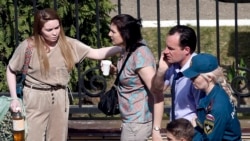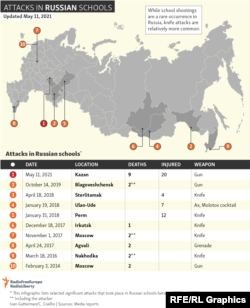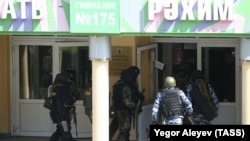The Columbine comparisons began as soon as word and video footage of the deadly attack on School No. 175 in Kazan emerged. But if school shootings were described less than a decade ago as a rarity in Russia, this time Russian headlines lamented “another” attack that echoed the infamous 1999 tragedy at a U.S. high school.
The May 11 attack in the Tatar capital -- in which at least nine people were killed and 21 wounded -- has been blamed on a disgruntled former student of the school equipped with a legally registered gun.
The bloodshed led to a clamor from Russian officials talking about ways to try to avoid such shootings in the future, including calls by President Vladimir Putin to impose controls on the types of weapons available to ordinary citizens.
It has also placed renewed focus on the growing list of shootings and other attacks on schools carried out by young people in Russia in recent years, and added to scrutiny of the government’s struggles to prevent what for years was seen mainly as a U.S. phenomenon.
In 2014, at Moscow's School No. 263, a 15-year-old carrying two rifles shot and killed a teacher and a police officer and took 29 classmates hostage before he gave himself up. Putin at the time called the incident "tragic," and the city's mayor ordered a comprehensive review of security measures at schools in the Russian capital.
In January 2018, 11 children and a teacher were injured in the Urals city of Perm when two 16-year-olds entered a classroom and slashed them with knives. Most of those injured, some seriously, were aged 10-12. One suspect was alleged to have posted a video of perpetrators of U.S. school attacks, including the two teens who carried out the Columbine massacre, on his VKontakte page.
Just days later, in a village outside the southern Siberian city of Ulan-Ude, a ninth-grader reportedly wearing a T-shirt resembling one worn in the Columbine attack injured four seventh-graders and a teacher with an ax and used a Molotov cocktail to set his former school ablaze.
And in October of the same year in Russian-occupied Crimea, 21 people were killed in a shooting and explosion at a university in the city of Kerch.
Russian state media were banned from making the connection to Columbine following the attack carried out by a shooter wearing clothing similar to that worn by the two teen perpetrators of Columbine, who fatally shot 12 fellow students and a teacher before killing themselves. As with the shooting at the Colorado high school shooting, the attack in Crimea was dubbed a "massacre."
Attempts At Prevention
Like other governments, Putin's has struggled to find ways to avert such attacks. Following the 2014 attack in Moscow, he suggested that a more well-rounded education might help prevent student-on-school violence.
"A new generation of spectators with good artistic taste should be brought up -- capable of understanding and appreciating theatrical, dramatic, and musical arts," Putin told theater workers in Pskov shortly afterward. "Had we been doing this properly, maybe there would have been no tragedies similar to today's tragedy in Moscow."
That school shooting was described by the media at the time as "incredibly rare" in Russia. Afterward, news that a guard was unable to prevent the armed pupil from entering the school led Moscow Mayor Sergei Sobyanin to order officials to conduct "a complete review of how our school security system is working, and to take additional steps."
Plenty of steps have been taken since to try to make schools safer around the country, adding to security measures implemented in the decade following the Beslan school siege, in which more than 330 people -- most of them children -- were killed in North Ossetia after militants took more than 1,000 hostages on the first day of school in 2004.
"We have security screens. We monitor the entrance to the school -- the rest of the school is surrounded by a perimeter fence -- and it has an automatic gate, so that you can see who is coming into the school," an official at a central Moscow school told RFE/RL three years after the siege. "We have a video-phone system on the gate. And in this way we can monitor who visits the school. These measures were brought in after Beslan."
In recent years, Russia has invested heavily in school security, including in an initiative to install "Orwell 2k" facial-recognition systems in more than 43,000 Russian schools as part of Putin's $25.4 million national digitalization project. The technology is intended to ensure safety by monitoring students' movements and identifying outsiders on school premises.
When the attack began on May 11, Kazan's School No. 175 had security measures in place for its some 1,000 students in grades one to 11 -- including an "action plan for the prevention of terrorism and extremism" last updated for the 2018-19 school year.
The plan advises students to "get to know each other better," and stresses the importance of sport, tolerance, and minimizing conflict. The school's website also provides links to the "municipal program for the prevention of terrorism and extremism in Kazan for 2016-2020."
But there were also conflicting reports about the presence of security guards at the school. Representatives of the Russian National Guard revealed on May 11 that there were no guards on the premises -- only a panic button to alert the National Guard.
There were also claims that private security guards stopped working at the school three years ago due to problems with payment. However, the Telegram channel In Kazan quoted Galina Ukhvanova, a deputy director at School No. 175, as saying that the security firm had been paid in full, and that the school had a guard on its staff.
Idel.Realities, of RFE/RL's Tatar-Bashkir Service, reported that the school said that a 62-year-old guard was on duty, and was hospitalized after the attack.
It is unclear how security precautions -- or the lack thereof -- may have affected the outcome of the attack on May 11.
Heavily armed police and emergency vehicles reportedly responded quickly, and video showed students streaming out of the school and, in some cases, jumping to their death from windows in the multistory school in an effort to escape.
Other videos showed students scrambling down fire-truck ladders to evacuate the school, while others show the wounded being treated outside the school.
Local Suspect
Grainy security-camera video posted to Telegram claimed to show the shooting suspect, whom Russia's Investigative Committee said it had identified as "a local resident born in 2001," walking along a street on his way to the school while brandishing a long gun. The regional interior minister said the attack was carried out by a 19-year-old shooter, who was apprehended, and media reports identified the suspect as Ilnaz Galyaviyev.
As investigators opened a mass murder case, Putin reportedly instructed the head of the Russian National Guard, Viktor Zolotov, "to hammer out new regulations on the types of weapons that are designated for civilian use, and which weapons may be in the possession of citizens, including the types of small arms the gunman used in this shooting."
Some applauded Putin on social media, pointing to the availability of firearms in the United States and the steady stream of school shootings that have taken place there in the last two decades.
Others suggested his steps may be misdirected.
Pavel Lokshin, a Moscow correspondent for the German newspaper Welt, tweeted: "I guess it’s safe to say that school shootings in Russia aren’t driven by the availability of firearms which is already pretty low. Besides, Putin did exactly the same thing after the Kerch shooting. Didn’t prevent Kazan."
Some Russian educators say that security measures aside, the state has taken steps that could be detrimental to efforts to curb school violence, such as cutting the number of psychologists in schools.
And while the May 11 attack raised questions about whether any warning signs had been overlooked, government critics say the state sometimes takes a heavy-handed approach in its efforts to avert school violence.
In 2020, the homes of several students in Siberia were raided following accusations they had taken part in a social-media chat room dedicated to the Columbine massacre.
Authorities claimed the teens had discussed a plot to attack a local school, and nine of them -- including a 14-year-old girl -- were forced to undergo involuntary examinations as a result.















